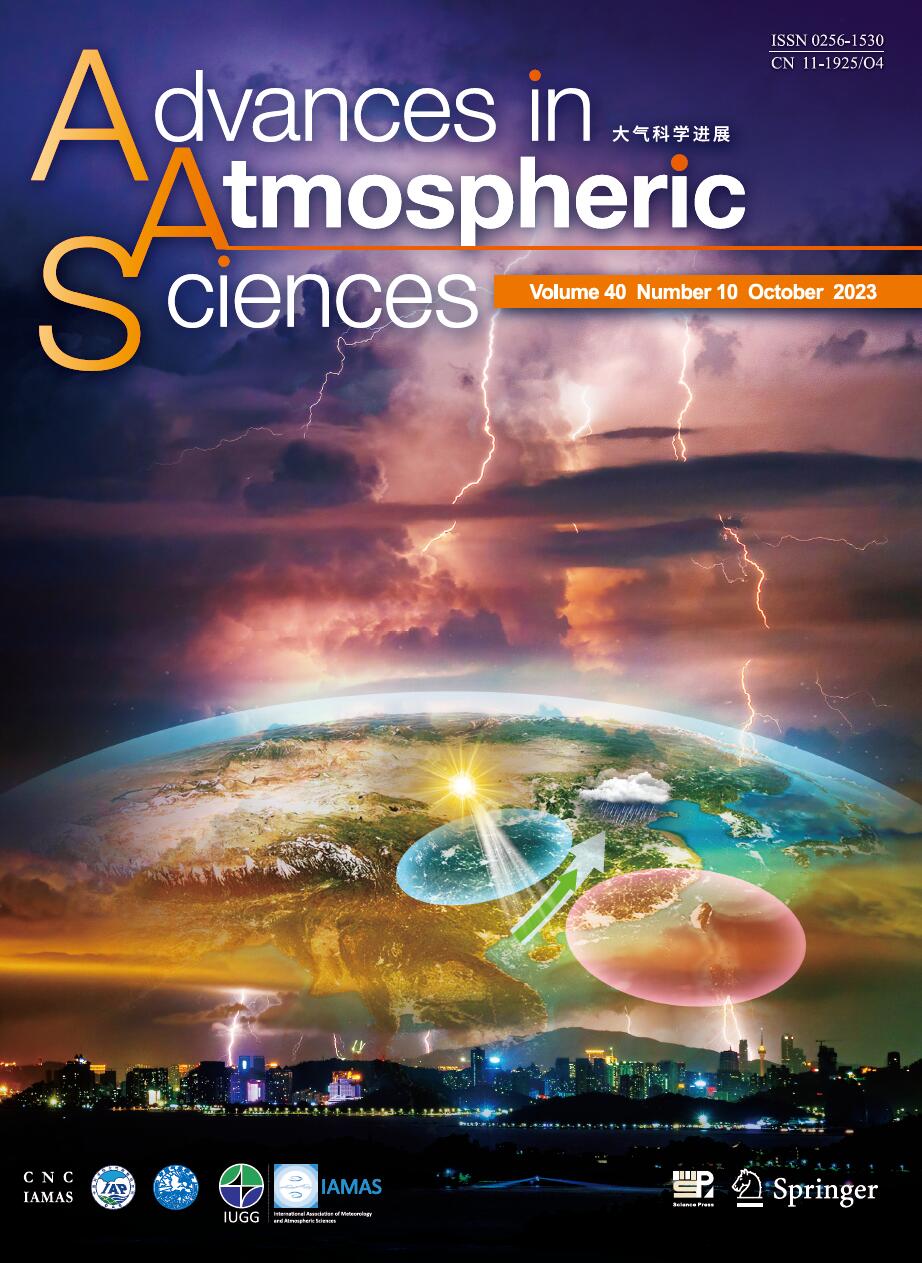| [1] |
YANG Jing, BAO Qing, JI Duoying, GONG Daoyi, MAO Rui, ZHANG Ziyin, Seong-Joong KIM,
2014: Simulation and Causes of Eastern Antarctica Surface Cooling Related to Ozone Depletion during Austral Summer in FGOALS-s2, ADVANCES IN ATMOSPHERIC SCIENCES, 31, 1147-1156.
doi: 10.1007/s00376-014-3144-1
|
| [2] |
JIANG Yujun, LIU Huizhi, SANG Jianguo, ZHANG Boyin,
2007: Numerical and Experimental Studies on Flow and Pollutant Dispersion in Urban Street Canyons, ADVANCES IN ATMOSPHERIC SCIENCES, 24, 111-125.
doi: 10.1007/s00376-007-0111-0
|
| [3] |
CHENG Xueling, HU Fei,
2005: Numerical Studies on Flow Fields Around Buildings in an Urban Street Canyon and Cross-Road, ADVANCES IN ATMOSPHERIC SCIENCES, 22, 290-299.
doi: 10.1007/BF02918518
|
| [4] |
ZHAO Haikun, WU Liguang*, and WANG Ruifang,
2014: Decadal Variations of Intense Tropical Cyclones over the Western North Pacific during 19482010, ADVANCES IN ATMOSPHERIC SCIENCES, 31, 57-65.
doi: 10.1007/s00376-013-3011-5
|
| [5] |
Hyo-Eun JI, Soon-Hwan LEE, Hwa-Woon LEE,
2013: Characteristics of Sea Breeze Front Development with Various Synoptic Conditions and Its Impact on Lower Troposphere Ozone Formation, ADVANCES IN ATMOSPHERIC SCIENCES, 30, 1461-1478.
doi: 10.1007/s00376-013-2256-3
|
| [6] |
HU Dingzhu, TIAN Wenshou, XIE Fei, SHU Jianchuan, and Sandip DHOMSE, ,
2014: Effects of Meridional Sea Surface Temperature Changes on Stratospheric Temperature and Circulation, ADVANCES IN ATMOSPHERIC SCIENCES, 31, 888-900.
doi: 10.1007/s00376-013-3152-6
|
| [7] |
PING Fan, GAO Shouting, WANG Huijun,
2003: An Improvement of the Mass Flux Convection Parameterization Scheme and its Sensitivity Tests for Seasonal Prediction over China, ADVANCES IN ATMOSPHERIC SCIENCES, 20, 978-990.
doi: 10.1007/BF02915521
|
| [8] |
YU Ye, Xiaoming CAI, QIE Xiushu,
2007: Influence of Topography and Large-scale Forcing on the Occurrence of Katabatic Flow Jumps in Antarctica: Idealized Simulations, ADVANCES IN ATMOSPHERIC SCIENCES, 24, 819-832.
doi: 10.1007/s00376-007-0819-x
|
| [9] |
Tianxue ZHENG, Yongbo TAN, Yiru WANG,
2021: Numerical Simulation to Evaluate the Effects of Upward Lightning Discharges on Thunderstorm Electrical Parameters, ADVANCES IN ATMOSPHERIC SCIENCES, 38, 446-459.
doi: 10.1007/s00376-020-0154-z
|
| [10] |
Yang Fanglin, Yuan Chongguang,
1993: Numerical Simulation of Regional Short-Range Climate Anomalies, ADVANCES IN ATMOSPHERIC SCIENCES, 10, 335-344.
doi: 10.1007/BF02658139
|
| [11] |
XU Zhifang, GE Wenzhong, DANG Renqing, Toshio IGUCHI, Takao TAKADA,
2003: Application of TRMM/PR Data for Numerical Simulations with Mesoscale Model MM5, ADVANCES IN ATMOSPHERIC SCIENCES, 20, 185-193.
doi: 10.1007/s00376-003-0003-x
|
| [12] |
Chen Yuejuan, Zheng Bin, Zhang Hong,
2002: The Features of Ozone Quasi-Biennial Oscillation in Tropical Stratosphere and Its Numerical Simulation, ADVANCES IN ATMOSPHERIC SCIENCES, 19, 777-793.
doi: 10.1007/s00376-002-0044-6
|
| [13] |
PING Fan, GAO Shouting, WANG Huijun,
2003: A Comparative Study of the Numerical Simulation of the 1998 Summer Flood in China by Two Kinds of Cumulus Convective Parameterized Methods, ADVANCES IN ATMOSPHERIC SCIENCES, 20, 149-157.
doi: 10.1007/BF03342059
|
| [14] |
Jianjun LIU, Feimin ZHANG, Zhaoxia PU,
2017: Numerical Simulation of the Rapid Intensification of Hurricane Katrina (2005): Sensitivity to Boundary Layer Parameterization Schemes, ADVANCES IN ATMOSPHERIC SCIENCES, 34, 482-496.
doi: 10.1007/s00376-016-6209-5
|
| [15] |
LI Weiping, XUE Yongkang,
2005: Numerical Simulation of the Impact of Vegetation Index on the Interannual Variation of Summer Precipitation in the Yellow River Basin, ADVANCES IN ATMOSPHERIC SCIENCES, 22, 865-876.
doi: 10.1007/BF02918686
|
| [16] |
ZENG Zhihua, DUAN Yihong, LIANG Xudong, MA Leiming, Johnny Chung-leung CHAN,
2005: The Effect of Three-Dimensional Variational Data Assimilation of QuikSCAT Data on the Numerical Simulation of Typhoon Track and Intensity, ADVANCES IN ATMOSPHERIC SCIENCES, 22, 534-544.
doi: 10.1007/BF02918486
|
| [17] |
Song Yukuan, Chen Longxun, Dong Min,
1994: Numerical Simulation for the Impact of Deforestation on Climate in China and Its Neighboring Regions, ADVANCES IN ATMOSPHERIC SCIENCES, 11, 212-223.
doi: 10.1007/BF02666547
|
| [18] |
Cheng Anning, Chen Wen, Huang Ronghui,
1998: The Sensitivity of Numerical Simulation of the East Asian Monsoon to Different Cumulus Parameterization Schemes, ADVANCES IN ATMOSPHERIC SCIENCES, 15, 204-220.
doi: 10.1007/s00376-998-0040-6
|
| [19] |
Zhang Yaocun, Qian Yongfu,
1999: Numerical Simulation of the Regional Ocean Circulation in the Coastal Areas of China, ADVANCES IN ATMOSPHERIC SCIENCES, 16, 443-450.
doi: 10.1007/s00376-999-0022-3
|
| [20] |
Guo Yufu, Zhao Yan, Wang Jia,
2002: Numerical Simulation of the Relationships between the 1998 Yangtze River Valley Floods and SST Anomalies, ADVANCES IN ATMOSPHERIC SCIENCES, 19, 391-404.
doi: 10.1007/s00376-002-0074-0
|















 AAS Website
AAS Website 
 AAS WeChat
AAS WeChat 
 DownLoad:
DownLoad: